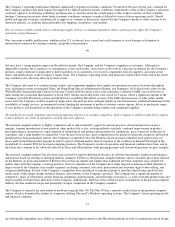Apple 2003 Annual Report Download - page 26
Download and view the complete annual report
Please find page 26 of the 2003 Apple annual report below. You can navigate through the pages in the report by either clicking on the pages listed below, or by using the keyword search tool below to find specific information within the annual report.
compares to 40 open stores as of September 28, 2002 and 8 open stores as of September 29, 2001. During the first quarter of fiscal 2004, the
Company opened 9 additional stores including its first international store in the Ginza in Tokyo, Japan. The Retail segment's net sales grew to
$621 million during 2003 from $283 million in 2002 and from $19 million in 2001. The $338 million or 119% increase in net sales during
2003 reflects the impact from opening 25 new stores in 2003, the full year impact of 2002 store openings, as well as an increase in average
revenue per store. Total Macintosh sales increased by approximately $170 million of which $108 million related to year-over-year increases in
PowerBook sales. The Retail segment has also contributed strongly to the increases in net sales of peripherals, software and services
experienced by the Company during 2003. During 2003, approximately 45% of the Retail segment's net sales came from the sale of Apple-
branded and third-party peripherals, software and services as compared to 28% for the Company as a whole. With an average of 54 stores open
during 2003, the Retail segment achieved annualized revenue per store of approximately $11.5 million, as compared to approximately
$10.2 million based on an average of 28 stores open in 2002.
As measured by the Company's operating segment reporting, the Retail segment improved from a loss of $22 million during 2002 to a loss of
$5 million during 2003. This improvement is primarily attributable to the segment's year-over-year increase in net sales, which resulted in
higher leverage on occupancy, depreciation and other fixed costs.
Expansion of the Retail segment has required and will continue to require a substantial investment in fixed assets and related infrastructure,
operating lease commitments, personnel, and other operating expenses. Capital expenditures associated with the Retail segment since its
inception totaled approximately $290 million through the end of fiscal 2003, $92 million of which was incurred during 2003. As of
September 27, 2003, the Retail segment had approximately 1,300 employees and had outstanding operating lease commitments associated with
retail store space and related facilities of $354 million. The Company would incur substantial costs should it choose to terminate its Retail
segment or close individual stores. Such costs could adversely affect the Company's results of operations and financial condition. Investment in
a new business model such as the Retail segment is inherently risky, particularly in light of the significant investment involved, the current
economic climate, and the fixed nature of a substantial portion of the Retail segment's operating expenses.
30
Gross Margin
Gross margin for the three fiscal years ended September 27, 2003 are as follows (in millions, except gross margin percentages):
Gross margin decreased to 27.5% of net sales in 2003 from 27.9% of net sales in 2002. This decline in gross margin reflects relatively
aggressive pricing actions on several Macintosh models instituted by the Company beginning in late fiscal 2002 as a result of continued pricing
pressure throughout the personal computer industry, lower sales of relatively higher margin Power Macintosh systems during the first three
fiscal quarters of 2003, and increased air freight and manufacturing costs associated with the production ramp-up of the new Power Mac G5
and 15-inch PowerBook, both of which began shipping in volume during September 2003. This decline is also attributable to a rise in certain
component costs as the year progressed. The aforementioned negative factors affecting gross margins during 2003 were partially offset by the
increase in higher margin software and direct sales.
The Company anticipates that its gross margin and the gross margin of the overall personal computer industry will remain under pressure
throughout fiscal 2004 in light of weak economic conditions, price competition in the personal computer industry, and potential increases in
component pricing. The Company also expects to continue to incur air freight charges on the Power Mac G5 and other products during 2004.
The foregoing statements regarding the Company's expected gross margin during 2004, general demand for personal computers, anticipated
industry component pricing, anticipated air freight charges, and future economic conditions are forward-looking. There can be no assurance
that current gross margins will be maintained, targeted gross margin levels will be achieved, or current margins on existing individual products
will be maintained. In general, gross margins and margins on individual products will remain under significant downward pressure due to a
variety of factors, including continued industry wide global pricing pressures, increased competition, compressed product life cycles, potential
increases in the cost and availability of raw material and outside manufacturing services, and potential changes to the Company's product mix,
including higher unit sales of consumer products with lower average selling prices and lower gross margins. In response to these downward
pressures, the Company expects it will continue to take pricing actions with respect to its products. Gross margins could also be affected by the
Company's ability to effectively manage product quality and warranty costs and to stimulate demand for certain of its products. The Company's
operating strategy and pricing take into account anticipated changes in foreign currency exchange rates over time; however, the Company's
results of operations can be significantly affected in the short
-
term by fluctuations in exchange rates.
2003
2002
2001
Net sales
$
6,207
$
5,742
$
5,363
Cost of sales
4,499
4,139
4,128
Gross margin
$
1,708
$
1,603
$
1,235
Gross margin percentage
27.5
%
27.9
%
23.0
%
























